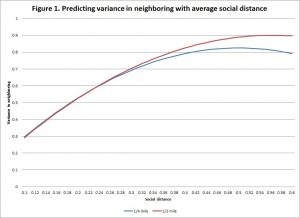Whereas existing research typically treats the variability in residents’ reports of collective efficacy and neighboring as measurement error, we consider such variability as of substantive interest in itself. This variability may indicate disagreement among residents with implications for the neighborhood collectivity. We propose using a general measure of social distance based on several social dimensions (rather than measures based on a single dimension such as racial/ethnic heterogeneity or income inequality) to help understand this variability in assessments. We use data from Wave I (2001) of the Los Angeles Family and Neighborhoods Study (N = 3,570) to aggregate respondents into egohoods of two different sizes: ¼ mile and ½ mile radii. Consistent with our expectations, neighborhoods with higher levels of general social distance have higher variability in the reports of neighboring and the two components of collective efficacy – cohesion and informal social control.
You can access the freely available article by Dr. John R. Hipp, Seth A. Williams, & Dr. Adam Boessen in Socius entitled, “Disagreement in Assessing Collective Efficacy: The Role of Social Distance”. The article examines variability in perceptions of collective efficacy among residents in neighborhoods in Los Angeles.
Get it here:
http://www.sciencedirect.com/science/article/pii/S0049089X16307931
Abstract:
Whereas existing research typically treats the variability in residents’ reports of collective efficacy and neighboring as measurement error, we consider such variability as of substantive interest in itself. This variability may indicate disagreement among residents with implications for the neighborhood collectivity. We propose using a general measure of social distance based on several social dimensions (rather than measures based on a single dimension such as racial/ethnic heterogeneity or income inequality) to help understand this variability in assessments. We use data from Wave I (2001) of the Los Angeles Family and Neighborhoods Study (N = 3,570) to aggregate respondents into egohoods of two different sizes: ¼ mile and ½ mile radii. Consistent with our expectations, neighborhoods with higher levels of general social distance have higher variability in the reports of neighboring and the two components of collective efficacy – cohesion and informal social control.
